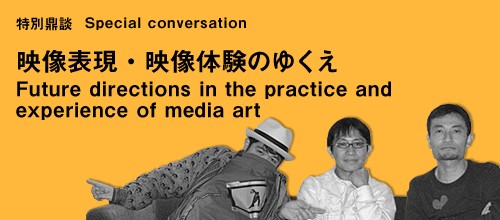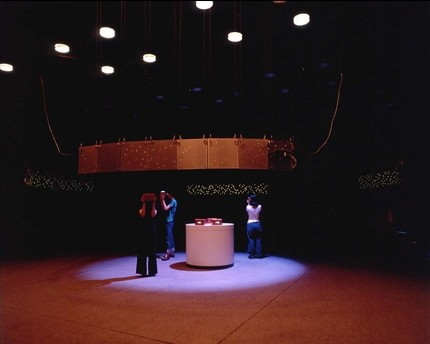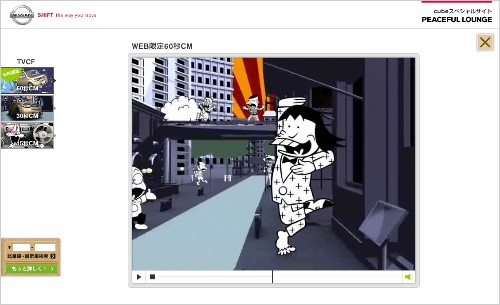
Ukawa Naohiro (CREAM competition juror)
Hachiya Kazuhiko (Participating artist)
Sumitomo Fumihiko (Director of the Festival)
The possibilities of audience-involvement-type projects
 Hachiya Kazuhiko Seeing is Believing1996 Photo: Oshima Kunio
Hachiya Kazuhiko Seeing is Believing1996 Photo: Oshima KunioHK Seeing is Believing, the work I showed at CREAM this time, was something I made 13 years ago but I think it’s in sync with the situation today where we’ve become used to experiencing the lives of others through blogs, webcams, and the like. Incidentally, when I went to check out the venue at Shinko Pier they were screening a work called BATON as part of Expo Y150 (the exposition marking the 150th anniversary of the opening of the port of Yokohama). The execution was pretty disappointing (laughs), and although the attempt to animate the actors’ performances by using motion capture technology and a few other things were interesting enough, things such as only being able to follow the story in one of the three parts and being able to hear the sound from the concert venue next door made one sense there was a kind of gap between the audience’s expectations and the producers, who seemed to take the attitude, ‘we’ve got this amazing spectacle so come and see’, which made me aware of the limits of the old-style exhibition films.
However, although it’s easy to criticize this kind of thing, it’s also a good opportunity to think about how you’d go about doing it yourself, and I came across a good example of this a while ago. I went to a filming session organized by Morimura Yasumasa at Sogetsu Hall in Aoyama that was open to the public. Apparently it was for a new work due to be shown at a solo show in 2010, and while they shot Morimura dressed as Marilyn Monroe playing the piano, they also shot the audience including myself from the opposite direction. We were given all kinds of directions such as ‘don’t look at the camera’, but at the same time I was thinking, this is great, I’m going to have to go and see this when it’s finished. In other words I was thinking how important it is these days to involve audiences and create the kinds of conditions that make them feel they have to see the work.
UN That special feeling you get when you’ve felt hungry for so long and finally reach your destination takes on a synergy and by telling others about it, it spreads. This kind of buzz networking is something the advertising industry was quick to pick up on. From simple brainwashing commercials they went in the direction of scattering ‘narremes’ based on viral marketing. As the term suggests, they spread viruses and the people who are infected then take over and spread them on their own.
For example, in the case of the television commercial for Otona Pocky, it’s them not yet revealing who Sazae-san is. The people who are infected with the narreme whereby Katsuo is Asano Tadanobu and Wakame is Miyazawa Rie start to spread the message on behalf of the marketers, with the speculation over the unknown Sazae-san inviting further speculation.
HK Speaking of commercials, I see you did a car commercial. For the Nissan Cube.
 Nissan CUBE TV commercial http://cube-lounge.nissan.co.jp/CONTENTS/usp.html
Nissan CUBE TV commercial http://cube-lounge.nissan.co.jp/CONTENTS/usp.htmlUN In a neat way that also became a buzz networking-like topic and the word got around. Before that when I was asked to do a music clip for The Orb I had the Doraemon characters and those archetypal Showa period scenes unfolding in a streetscape constructed at Tentomushi Comics. So that was the idea behind the original. I put it together after being inspired by a show by the fashion brand LAD Musician, and the original version was quite a hit at the time. Then one day nine years later I was contacted by an advertising agency with a ‘proposal’, which was that they wanted to do the same thing but this time with Akatsuka Fujio characters. And so it was that the Cube commercial was born. The approach is similar to the MAD movies you see on Nico Nico Douga (Note: fan-made videos in which other users edit and/or reconstruct existing videos), and I thought if I could do a similar thing in my own living room but using my own video it would be cool. What’s more, there was a long version that was officially released on YouTube and Nico Nico Douga at around the same time and the response was such that sales of the car rose, plus TOKYO NO.1 SOULSET + HALCALI’s cover of “Konya wa Boogie Back”, which played as the BGM, was also a hit, as a result of which downloads exceeded 500,000…. So it was quite successful. Even in the context of this kind of communication based on a buzz network where TV is the source but where it spreads on the Internet, video is the most important medium. In this realm one weird inversion phenomenon occurs after another, such as the Orb clip, which is actually the original, attracting comments like “This is a rip-off of the Cube commercial, right?”, people guessing it’s a song by Perfume, and MAD movies based on the TV commercial being repeated in a kind of vicious circle (laughs).
SF In which case the myth of originality completely collapses, doesn’t it?
HK If that’s the case I have one question. Which is that there were all these interesting works at this festival, but was it really necessary to be there to experience them?
UN This festival is a case in point, but another example of a format where it’s still imperative that you experience it on-site is the installation. Also, there are still issues with respect to things like sound and projection on-site, while at the same time there are merits in terms of the aura that surrounds such venues.
HK Certainly, because my own piece this year was an installation there were merits in exhibiting it in a place like Shinko Pier. But in the case of works that could just be shown on a normal screen, a part of me also felt, just show them on the Internet with a PC monitor.
SF Artists who do video installations these days are really particular about things like the exactness of the screen size and the angle of multiple screens, to the extent that you’d think they were sculptures. Because this kind of thing affects the bodily experience of the audience. It’s the same with the sound. Of course, it’s fine that there are works that can be viewed on the Internet, and on the contemporary art side of things there are leading figures like Fischli & Weiss who upload their works onto the Internet, but I think there are still differences between the two.
Peter Fischli and David Weiss The way things go 1987 (digest)
Reconsidering ‘video communication’
SF Audience involvement has been mentioned, but one of the sources of inspiration for this festival is the kind of thing being done by Michel Gondry. He’s a famous film director, but he also came up with a protocol according to which anyone can make a movie in two hours, which he’s used as the basis for an exhibition and also published as a book. And so at the festival we held a workshop called the Neighborhood Movie Club in which everyone made a movie together using this Gondry method. The important thing is not to have a single autocratic director whom everyone else obeys but to have everyone equidistant from the work. The protocol is well thought out so everyone can make the film together and then have a good laugh together while watching the results. In the book, Gondry openly expresses a strong dislike for certain critics, stating that those who haven’t made anything are in no position to comment on other people’s movies, that this is the responsibility of those who took part.
Promotional short movie for You’ll Like This Film Because You’re In It: The Be Kind Rewind Protocol
– If we agree that the importance of live camera footage that came up earlier in the discussion and this talk of audience involvement are trends that arose at around the same time, what, then, is the relationship between the two?
HK There’s a video called Where the Hell is Matt?, in which a guy called Matt does this crazy dance – sometimes together with locals – in various locations around the world, and I think this fits somewhere in between the two trends you just referred to in your question. He shot parts of it in Harajuku and Akihabara in Tokyo, so you think its something you could do as well and that you could have been there with Matt. At the same time, you see lots of footage of countries you’ve never been to, giving you a sense of the diversity of the world. Also, it puts you in a kind of happy mood (laughs).
Where the Hell is Matt? http://www.wherethehellismatt.com/
UN If there’s one thing I could say that borders on an answer it would be that neither of these two trends include a kind of ‘success vs. failure’ mentality. Perhaps ‘failure’ as a potential destination point doesn’t even exist? Because rather than the finished video it’s the actual communication that’s the objective. If this is the case, these are likely not ‘artworks’, at least not in the traditional sense. No one can criticize footage showing puppies growing. And it’s precisely because they aren’t so-called ‘artworks’ that Gondry was angry at people who criticized the movies everyone makes together, I’m sure. They’re experiments in which there’s neither success nor failure. Also, failures are the foundation for success in the sense that they are acts in which one-off accidents are actually welcomed as allies.
HK Certainly, assuming that we’re talking about artworks, Gondry’s criticism of critics that was mentioned a while ago is a bit naive. At the same time, saying that there’s neither success nor failure is connected to the lack of dramatic elements that we talked about earlier. Leaving aside what might have been the case in the past, nowadays this is certainly the case. I mean, even something like Neko Nabe (Cat Pot) on Nico Nico Douga, which is simply a video of cats sleeping in earthen pots, attracts heaps of viewers.
UN Ultimately, I think it comes down to being aware of which phase of ‘artwork’ or expression we’re talking about. I’m actually in the process of setting up a dedicated live streaming channel with the aim of finding out where this approach might ultimately lead. With so many video-sharing sites around these days and everything from episodes of Gilgamesh Night to Nam June Paik’s video art archived on the Internet and able to be played on the same level, I think we’ve reached the stage where rare documentary video in the true sense of the term no longer exists. Which is precisely why I think what’s important now is the degree to which one can assign scarcity value to the feeling that something is live and whether one can give form to the networks themselves, including these videos, as expression.
For example, in broadcasting using three cameras a DJ performing live, the important thing is that no matter where in the world they are people can experience simultaneously the DJ ‘playing this particular song now’, and depending on the way this is shown it could be regarded as an artwork (in a sense different from before). It’s the kind of expression we discussed earlier in which we can watch one-off accidents that happen to occur in the context of mundane everyday life, and in which these live acts are scattered to all parts of the world in the form of video. It’s precisely because these are live events that people will never have the chance of experiencing simultaneously again that they have value, and if we were to assign value to video documenting these acts it would be as an action linking the past and the present. If this is successful, then perhaps we can even transform the meaning of the present. Although propositions like this that are in a sense artworks but in another sense not are something I’m used to already. Because I’m also a graphic designer who imagines himself occupying a position somewhere between artistry and anonymity.
HK It just occurred to me that, if you think about it carefully, audience involvement and everyone wanting to watch video in which they appear are both elements already present in the Inter Dis-Communication Machine, which I built 16 years ago. I’m a genius in spite of myself. Well, it’s a coincidence of course (laughs). Also, basically I’m not a video artist, although I’ve been inspired by today’s discussion to think again about how best to document and present in video form my ongoing flying machine project, OpenSky. There’s a limit to the number of people who can be present on-site, and the only way to get the message across to large numbers of the general public is through video. However, because there’s a clear line between success and failure in the form of whether it flies or not, I’m going to have to think of how best to get the message across in a way in which this aspect alone isn’t emphasized.
Trailer for Hachiya Kazuhiko: OpenSky2.0 (2006-07, NTT InterCommunication Center)
UN That’s got to be live streaming!! If you transmit live footage of two or three people failing and falling to their death, you’ll be the topic of conversation everywhere (laughs). We’re talking Faces of Death and Death File the End territory, only live (laughs).
HK Except it’s me who’s the pilot every time (laughs wryly).
SF At this festival, too, with the exception of the screening programs, what you might call narrative works were practically nonexistent. The idea behind the theme of ‘DEEP IMAGES’ was to encourage people to actively ask themselves what exactly it is they’re watching now when they’re confronted with various moving images. Of course this is something closely related to today’s discussion.
– Everyone, thank you very much for taking part today.
Ukawa Naohiro
Born 1968 in Takamatsu. Media artist, VJ, writer, graphic designer. Director of MOM/N/DAD PRODUCTIONS and Mixrooffice. Lecturer in the Image Media Course, Department of Information Design, Kyoto University of Art and Design. Launching the live-streaming studio, DOMMUNE, in Hiroo in 2010.
http://www.ukawa.tv/
Hachiya Kazuhiro
Born 1966 in Saga. Media artist. Known as the developer of the email application PostPet, he is also director of Petworks, a company engaging in PostPet-related software development and direction.
http://www.petworks.co.jp/
Sumitomo Fumihiro
Born 1971 in Tokyo. Following curatorial posts at the 21st Century Museum of Contemporary Art, Kanazawa in preparation for its opening, NTT InterCommunication Cener (ICC) and the Museum of Contemporary Art Tokyo (2006-08), acted as director of the CREAM International Festival for Arts and Media Yokohama. He is also a founding director of the non-profit Artists Initiative Tokyo (AIT).
http://ifamy.jp/
